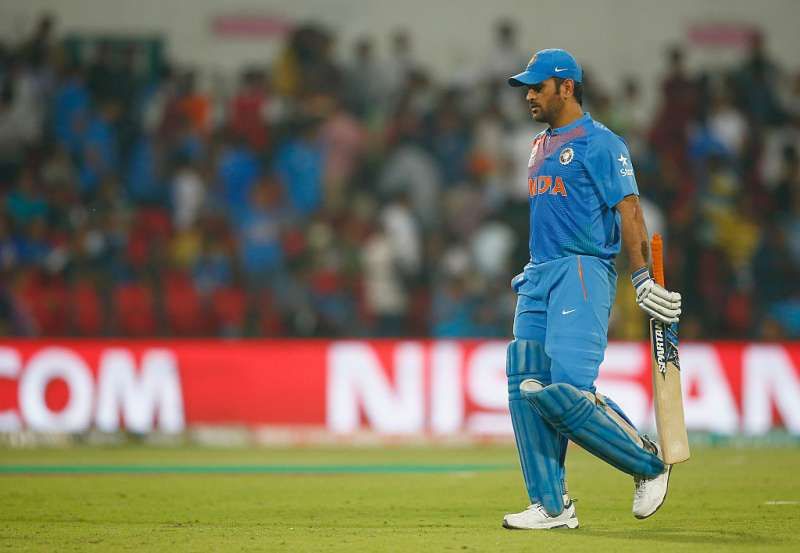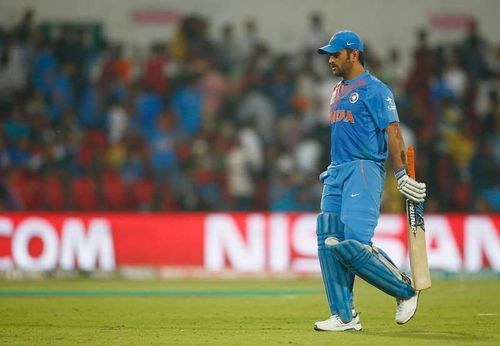
Does MS Dhoni's move to the middle order signal a demise of the finisher?

In June 2015, sports media portals were buzzing with conjecture on rifts in the Indian dressing room. Having been soundly defeated in two consecutive ODIs in Bangladesh, questions were being raised on Dhoni’s tenure as captain and rapidly diminishing skills as a lower order batsman.
Despite having lost the series, Dhoni decided to promote himself to no. 4 in the final ODI to much success. In the post-match presentation, he expressed discontent with his ability to freely score runs and felt the time had come for him to adopt a stabilizing role in the middle order.
Also read: Sourav Ganguly feels Axar Patel was promoted to take the pressure off MS Dhoni
Those words and nascent strategies were forgotten by the next major ODI series, and a cycle was set in motion.
In the present, Dhoni’s finishing skills have come into question once again, followed by a similar expression of discontent with his ability to score with unbound liberty and a resolute desire to bat at no. 4.
If I hadn’t watched the spectacle unfold before in Bangladesh in 2015, I would concur this is a permanent transition. But something, call it gut instinct, tells me he’ll happily slot down to his preferred no. 5 or no. 6 position the moment Suresh Raina waltzes his way into the team. But should he?
The unspectacular change
Dhoni has undergone multiple transformations throughout the years. Ever since he was entrusted with captaincy (IPL aside) Dhoni’s inherent aggression was curbed by a tactician’s meticulous tendencies. A Dhoni that would happily thump sixes out of the ground now preferred to nudge the ball around and take the match to the last over.
Yet, with time, he lost his ability to finish things off in the end, and was often left shame-faced but never publicly ridiculed.
In retrospect, the signs were ominous and worryingly frequent - the India-England T20 in Birmingham where he famously denied strike to Ambati Rayadu in the last over, against South Africa in 2015, Australia in 2016, Zimbabwe in 2016 and the solitary T20 in Lauderhill.
Also read: Analyzing Dhoni's batting woes: Is it waning of hitting skills or just a lack of confidence?
Dhoni’s attitude to a situation in which he required 2 runs off 1 ball was the most telling sign of a batsman who is no longer what people purport him to be. No finisher or aggressor would ever look to nudge a ball to tie the game hoping for a Super Over when faced with 2 off 1, yet Dhoni attempted and failed spectacularly.
Having lost the intrinsic aggression and subjected himself to an immersive dome of overthinking, Dhoni has often treated run-a-ball situations with indolence, relying on a (false) presumption that he would finish it off in the end. Apart from the aforementioned incidents, often he has found himself dismissed much earlier, leaving the tail with the prospects of chasing down a relatively tougher target than that when he came to the crease.
Promotion up the order could be key
Given his talent and experience, MS Dhoni at no. 4 might be the best thing going forward. There is no refuting his talent – for he has buckets of it to have been able to solidify a career from a batting and wicketkeeping technique that would be a conventional coach’s nightmare. He also possesses one of the best cricketing brains in the game today, and his game plans would be a lot more effective if he gave himself the time and space to settle in.
It’s also important that he gets more balls in the middle – a man who spends half the year not playing cricket can no longer be expected to smash balls into oblivion from the instance he takes guard. Take into account that the 35-year-old MS Dhoni with 9 years of captaincy experience is less inclined to smash balls into oblivion due to overbearing caution, and it’s a clear signal that his current form of play suits the middle order.
A mildly perceptive reader can easily pick out my bias in this debate – I believe Dhoni in the middle order is the way forward for Indian cricket. However, there is an extremely robust argument that would defend his right to remain a finisher (despite evidence to his depreciating ability) – he has been one of the most successful finishers in his prime, with a runs tally, not-outs tally and a high average as bragging rights.
Should teams adapt accordingly?
This also brings to the fray a bigger question – should teams adapt to a change in a player’s playing style?
If Virat Kohli suddenly loses his ability to handle the new ball, yet asserts mastery over an older one, is it then fitting to relegate him lower down the order? Or should we persist with Kohli at the top due to his sublime past records?
If preserving talent is the key, which would explain Rohit Sharma’s inclusion in the Test team and subsequent trials with all possible batting positions, shouldn’t we extend that philosophy to established players who are no longer fit for their favorite slot?